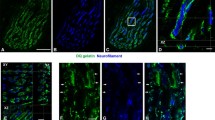Summary
The differentiation of neuromuscular junctions of multiply innervated, slow, anterior latissimus dorsi (ALD) and focally innervated, fast, posterior latissimus dorsi (PLD) muscles was studied in normal and curarized chick embryos. At 16 days of incubation, fibres of both muscles are contacted by several axon profiles, the number of which falls with age. In 18-day-old embryos individual endplates in ALD are usually contacted by three axon profiles, whereas in PLD, endplates are contacted only by a single large terminal profile. At this time, there is already a significant accumulation of cell organelles in the postsynaptic area.
Treatment of embryos with curare during the 7th and 12th day of incubation delays the differentiation of the neuromuscular junction in both muscles. The paralysis dramatically affects the decrease of the number of axon profiles at individual endplates in both muscles. At 16 days the number of axon profiles was greater in embryos treated with curare than in the untreated controls. At 18 days when the number of axon profiles normally decreases, the endplates of both types of curarized muscles have an even greater number of axon profiles than at 16 days. Endplates in curarized PLD had up to 13 and in curarized ALD up to 12 axon profiles. The effects of curare gradually wore off and when the movements of the embryos again became more vigorous, the normal differentiation of neuromuscular junctions continued. At 21 days of incubation many embryos recover from curare and show endplates of normal appearance in both muscles. These results suggest that activity of the muscle is essential for the maturation of the neuromuscular junctions.
Similar content being viewed by others
References
Anderson, M. J., Cohen, M. W. andZorychta, E. (1977) Effects of innervation on the distribution of acetylcholine receptors on cultured muscle cells.Journal of Physiology 268, 731–56.
Atsumi, S. (1977) Development of neuromuscular junctions of fast and slow muscles in the chick embryo: a light and electron microscopic study.Journal of Neurocytology 6, 691–709.
Bagust, J., Lewis, D. M. andWesterman, R. A. (1973) Polyneuronal innervation of kitten skeletal muscle.Journal of Physiology 229, 241–55.
Bennett, M. R. andPettigrew, A. G. (1974) The formation of synapses in striated muscle during development.Journal of Physiology 241, 515–45.
Benoit, P. andChangeux, J. P. (1975) Consequences of tenotomy on the evolution of multi-innervation in developing rat soleus muscle.Brain Research 99, 354–8.
Brown, M. C., Jansen, J. K. S. andVan Essen, D. (1976) The polyneuronal innervation of skeletal muscle in new born rats and its elimination during maturation.Journal of Physiology 261, 387–422.
Cohen, M. W. (1972) The development of neuromuscular connexions in the presence of D-tubocurarine.Brain Research 41, 457–63.
Couteaux, R. (1963) The differentiation of synaptic areas.Proceedings of the Royal Society of London, Series B 158, 457–80.
Drachman, D. B. (1968) The role of acetylcholine as a trophic neuromuscular transmitter. InGrowth of the Nervous system (edited byWolstenholme, G. H. andO'Connor, M.) pp. 251–273. London: Churchill.
Freeman, S. S., Engel, A. G. andDrachman, D. B. (1976) Experimental acetylcholine blockade of the neuromuscular junction. Effects on endplate and muscle fiber ultrastructure.Annals of the New York Academy of Sciences 274, 46–59.
Gordon, T., Purves, R. D. andVrbová, G. (1977) Differentiation of electrical and contractile properties of slow and fast muscle fibres.Journal of Physiology 269, 535–47.
Gutmann, E., Hanzlíková, V. andHolečková, E. (1969) Development of fast and slow muscles of the chickenin vivo and their latent period in tissue culture.Experimental Cell Research 56, 33–8.
Hess, A. (1967) The structure of vertebrate slow and twitch muscle fibres.Investigative Ophthalmology 6, 217–28.
Hudlická O. (1969) Resting and postcontraction blood flow in slow and fast muscles of the chick during development.Microvascular Research 1, 398–402.
Korneliussen, H. andJansen, J. K. S. (1976) Morphological aspects of the elimination of polyneuronal innervation of skeletal muscle fibres in new born rats.Journal of Neurocytology 5, 591–604.
Nyström, B. (1968a) Histochemical studies of endplate bound esterases in ‘slow-red’ and ‘fast-white’ cat muscles during post-natal development.Acta neurologica Scandinavica 44, 295–318.
Nyström, B. (1968b) Postnatal development of motor nerve terminals in ‘slow-red’ and ‘fast-white’ cat muscles.Acta neurologica Scandinavica 44, 363–83.
O'Brien, R. A. D., Purves, R. D. andVrbová, G. (1977) Effect of activity on the elimination of multiple innervation in soleus muscles of rats.Journal of Physiology 271, 54P.
O'Brien, R. A. D., Östberg, A. J. C. andVrbová, G. (1978) Observations on the elimination of polyneuronal innervation in developing mammalian skeletal muscle.Journal of Physiology (in press).
Östberg, A. J. C. andVrbovä, G. (1977) Illustration of the disappearance of polyneuronal innervation of developing skeletal muscle.Journal of Physiology 271, 6P.
Redfern, P. A. (1970) Neuromuscular transmission in new born rats.Journal of Physiology 209, 701–9.
Reynolds, E. S. (1963) The use of lead citrate at high pH as an electron opaque stain in electron microscopy.Journal of Cell Biology 17, 208–12.
Rosenthal, J. L. andTaraskevich, P. S. (1977) Reduction of multiaxonal innervation at the neuromuscular junction of the rat during development.Journal of Physiology 270, 299–310.
Steinbach, J. H., Harris, A. J., Patrick, J., Schubert, D., andHeineman, S. (1973) Nerve-muscle interactionin vitro. Role of acetylcholine.Journal of General Physiology 62, 255–70.
Zelená, J. andJirmanová, I. (1973) Ultrastructure of chicken slow muscle after nerve cross union.Experimental Neurology 38, 272–85.
Author information
Authors and Affiliations
Rights and permissions
About this article
Cite this article
Srihari, T., Vrbová, G. The role of muscle activity in the differentiation of neuromuscular junctions in slow and fast chick muscles. J Neurocytol 7, 529–540 (1978). https://doi.org/10.1007/BF01260887
Received:
Revised:
Accepted:
Issue Date:
DOI: https://doi.org/10.1007/BF01260887



